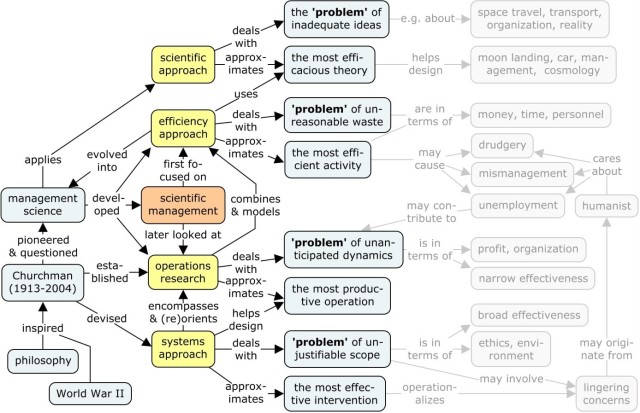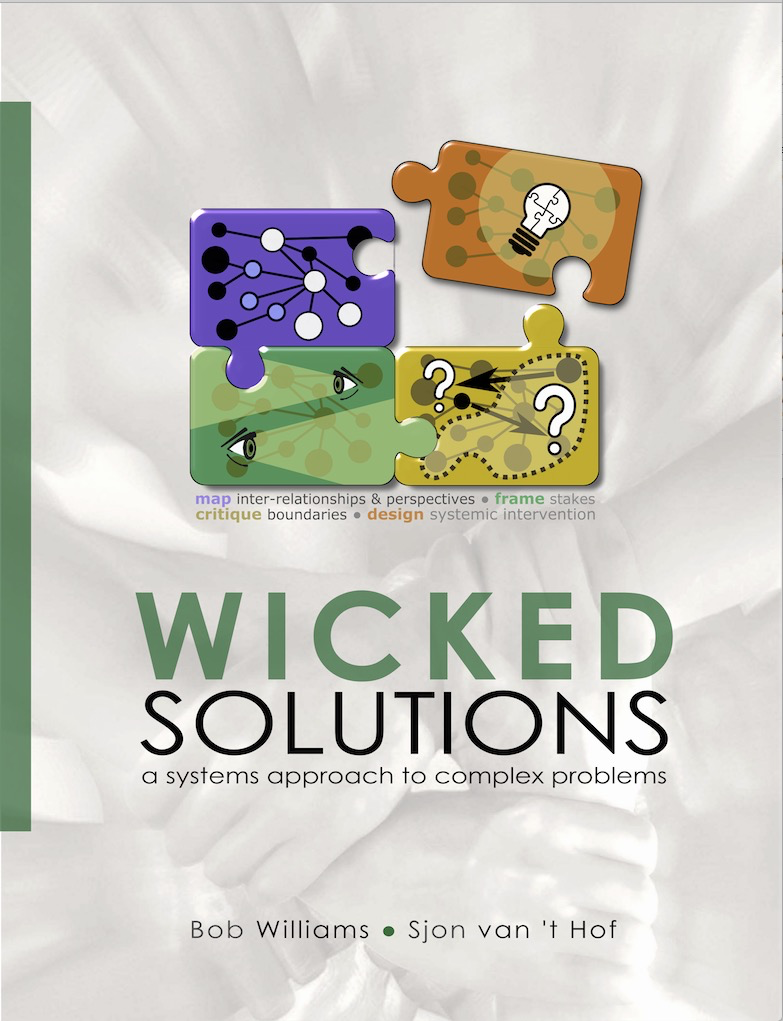Four approaches and two meanings of ‘approach’
When I first read Churchman’s ‘The systems approach’ I was missing a bit of structure to let everything fall into place. I went on to read more of his books and other systems books to get to grips with the subject. I gradually became convinced that perseverance won’t harm a person bent on getting to the bottom of systems thinking. I am currently rereading the same book (‘The systems approach’) that I started off with a couple of years ago and I believe I have made some progress since then. So here is my new version of my reading and interpretation of ‘Chapter 2. Efficiency’ (pp. 16-27). It provides an alternative way for quickly understanding what the systems approach is about, by situating it in a context of other approaches most people are more familiar with.
The efficiency approach Churchman has worked as a management consultant before anybody had thought of the term. As such he has worked a lot with people who talked a lot about efficiency in its various guises. Efficiency is all about getting rid of unreasonable waste in terms of money, time, or equipment. Churchman gives several examples: (1) unused inventories; (2) idle equipment; (3) overstaffed workforce (in bureaucracies or hospitals); and (4) ill-targeted welfare assistance (due to dishonesty). There is huge ‘slack’ in our government and business organizations, so “cost reduction programs always make sense within the narrow confines of each division of the organization.” However, according to the management scientist, mere attention to cost reduction by itself may be counter-productive due to feedback mechanisms. A productivity approach (operations research) could prevent that.
A productivity approach The question is: what’s wrong with efficiency in a narrow sense? And if anything is wrong, how should you best avoid it? That’s where operations research comes in. In fact, Churchman helped establish operations research in enterprises as an academic discipline, after he had worked in operations research for military operations during World War II. A good example is an airport with a single airstrip, where busy periods are alternated with periods of slack. On average, there may seem to be room for increased efficiency, i.e. more aircraft, but in practice there may be the problem of planes having to wait too long, which is also a form of inefficiency. In such a case one inefficiency has to be balanced with another. To do so requires a mathematical probability model and some calculation power in the form of a computer. One might say that operations research is a kind of (overall) productivity approach.
An effectiveness approach The systems approach is all about effectiveness in a broad sense and could therefore be called the effectiveness approach. Just like operations research could be considered a comprehensive version of the efficiency approach, the systems approach encompasses operations research. Whereas efficiency means “doing the thing right,” effectiveness means “doing the right thing.” This gives the systems approach primacy over the other two. Before you can start doing the thing right, you must make sure that you are doing the right thing. Or else, it will mean you are wasting a terrible amount of money, time and personnel.
How the systems approach works? An example of how the systems approach works can be found in above concept map: one of the effects of the efficiency approach can be unemployment. From a humanist’s point of view this may be a cause for concern, simply because people need work to be happy and to earn money to function normally in our modern society. However, this is not necessarily a bad thing; a gradual increase in work productivity is part of a healthy economy. Yet, suppose now that the efficiency approach leads to so much unemployment that the increase in work productivity per worker no longer leads to an increase of productivity of the society as a whole. As a consequence there may be fewer buyers for the products that are produced more efficiently. So, what first looked like a concern for the idealist suddenly gets a practical twist. By defining the scope for operations research to narrowly, this important aspect is kept out of sight. By bringing it into the planning process, it may be possible to resolve the issue with benefits for all concerned.
The scientific approach Churchman is a management scientist, who has worked at Berkeley for most of his academic career. Now, I defined the scientific approach as the approach that deals with the problem of inadequate ideas. Take gravitation: before Newton, people knew very well that things fall to the ground. The difficulty was how to describe this in a way that we can apply the principle to all sorts of object, including planets and satellites. So Newton managed to do that in a very neat mathematical way. But how efficacious was his theory. Could gravitation be described in an even better way? Einstein used some simple thought experiments to show that Newton’s theory was inadequate and went on to develop his general theory of relativity. Churchman did something similar. He saw that the narrow effectiveness of operations research was not enough and developed his theory of the systems approach to enlarge the scope of inquiry, using his double background in operations research and philosophy (more later, see also the rest of this blog).
The four approaches compared The idea of contrasting approaches is entirely Churchman’s. The idea to compare and tabulate them is mine. I won’t claim to have followed Churchman to the letter. I leave the reader to look at the table without much comment. The focus of the systems approach is to determine whether some human activity makes sense or not. Whether or not the systems approach yields quick results depends on a lot of factors, which is why I added an asterisk to my characterization of the speed of adjustment of the situation. For more information see my post on Thinking in systems: twelve leverage points for systemic intervention design.
Name of the systems approach The term ‘systems approach’ is composed of two words: systems and approach. Both words have a double meaning. Let’s start with ‘systems’. The systems approach in a broad sense is an approach for inquiring how well components of a system work and interact to achieve purpose. It is important to recognize that the word system here does not mean an easily identifiable system, but rather a diffuse ‘whole’, the boundary and relevant content of which needs defining as part of the approach. As to the systems approach in a narrow sense: according to Churchman, human activity is best conceived as a (teleological) system using a set of nine conditions. This implies that the act of applying these nine conditions as a heuristic for systemic inquiry and design is the systems approach (in a narrow sense). The purpose of the systems approach is to understand a complex situation or ‘wicked problem’ as well as possible and to address this by designing the most effective intervention imaginable. Any particular way thinking about or dealing with something is an approach. In the case of wicked problems it is normally only possible to deal with them in an approximative sense. This is the second meaning of ‘approach’.
Relevance of the systems approach Some people may not directly see the relevance of the systems approach. To do so, it is best to look at two common other approaches, the efficiency approach and operations research, as we did above. Operations research is a way of taking into account important feedback mechanisms that thwart the effectiveness of the efficiency approach. Similarly, the systems approach is a way of taking into account human perceptions that thwart the effectiveness of operations research. The scope of operations research may be relatively broad, but it usually excludes human values, since they are considered immaterial. The interesting thing, though, is that human values, human motivation and human perspectives are closely intertwined. By letting them in, especially in the form of several of the most relevant perspectives, it is possible to get a more complete view of the wicked problem at hand and the possible choices that could be make up a solution. This process is often known as ‘sweeping in and unfolding’: additional ‘environmental’ factors, motivations, perspectives are swept in and the implications of their inclusion for the wicked problem and its possible solution are unfolded. If done properly by willing and knowledgeable stakeholders, this can lead to more outside the box, innovative and effective solutions than would otherwise be the case. Methodologically, much will depend of course on the original logic and correct application of the nine-condition heuristic (see elsewhere in this blog). Another issue is the fact that some people may have totally different approaches to wicked problem and are unable to acknowledge the need for a systems approach. Often these are the so-called enemies of the systems approach.
P.S. systems approach Here follows a description of the systems approach using the attributes of the table above. The systems approach was developed by Churchman for human activity systems, i.e. in fact all systems involving people, both as participants (decision-maker, client, beneficiary, designer, planner) or as spectators. The results of its application are innovations or novel designs for human activities in the form of ‘effective interventions’. The underlying problem in a generic sense is that the scope for the original activity could not be justified, i.e. failed to make sense, which gave one or more participants a sense of urgency for change, the so-called heroic mood. The overt problem is typically something called a ‘wicked problem‘ (or problematic situation), i.e. a problem that is complex and not solvable in linear fashion. If it would have been easy to solve, one of the other approaches would have worked well enough. The (re)solution model is that of non-linear planning, often with an adaptive or co-creative element. The systems approach is value-inclusive, i.e. takes human values and motivations seriously. To do so practically and effectively, it makes use of the doctrine of teleology, which holds that final causes, design, and purpose exist in (human) nature. I called this doctrine soft teleology to differentiate it from the cybernetic, hard teleology used in operations research. The systems approach in a narrow sense is the application of a set (or heuristic) of nine (or twelve) teleological categories to a problematic situations. According to Churchman, the essence of the systems approach can be summarized by the four principles of deception-perception. In practice, this implies that every perspective is “terribly restricted”. By means of critical debate the different perspectives can be combined to get a better overall view of the system as whole*. There is no predetermined limit to the system as a whole, but in but in practice a so-called boundary critique among key participants will indicate what is relevant within a multi-dimensional boundary and what is not. To this end, the scope of inquiry must be expanded. The systems approach was designed to achieve broad, long-term effectiveness in terms of time, space, and values. In practice, the process of adjustments necessary for carrying through an effective intervention design, can be difficult and slow. This too can be part of the intervention design. A full description of the systems approach is tedious. You can easily see that it differs strongly from the other three approaches (see table). The systems approach was designed as a necessary complement to these earlier approaches. The best way to appreciate the systems approach and its practical value is by applying it to a problem of your own. One of the easiest ways for doing so is explained in Wicked Solutions, a workbook designed for the purpose.
The final touchstone ….for the success of judgments based on the systems approach is simple: does the result make sense to the key stakeholders involved after the risk of deception has been minimized by applying the various teleological and epistemic principles.



